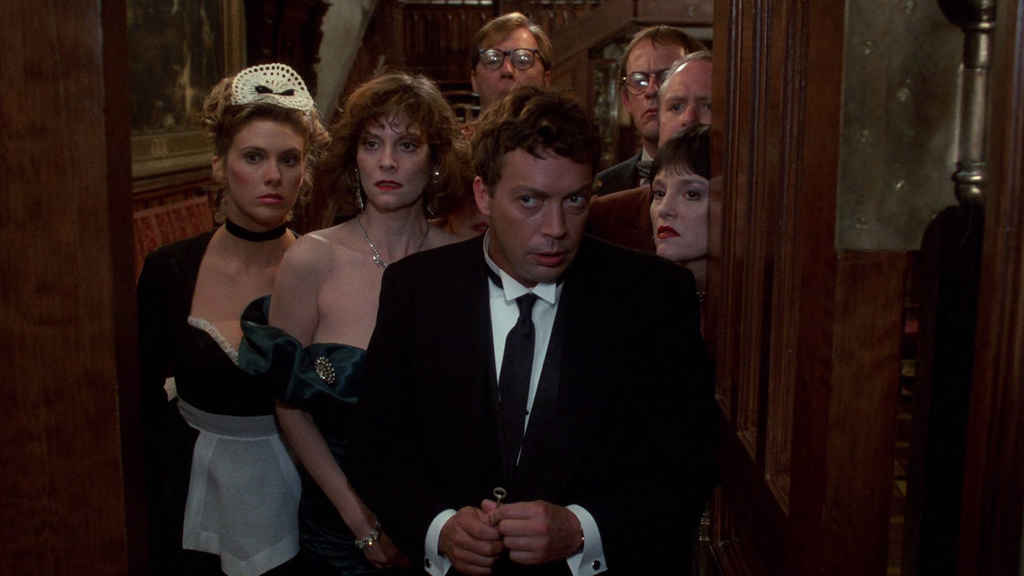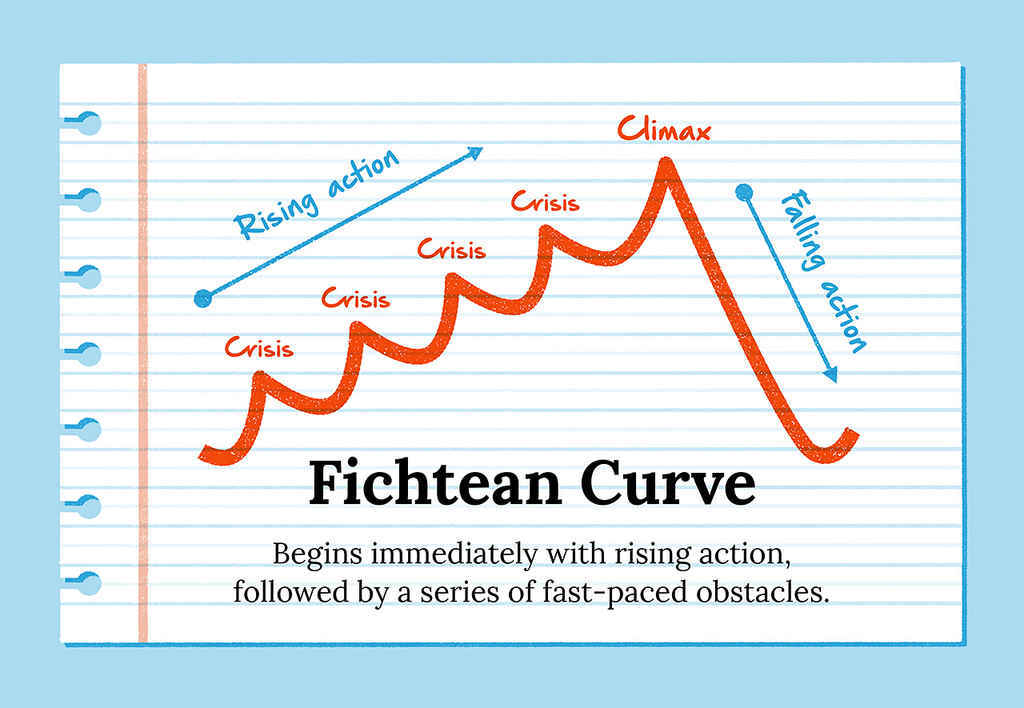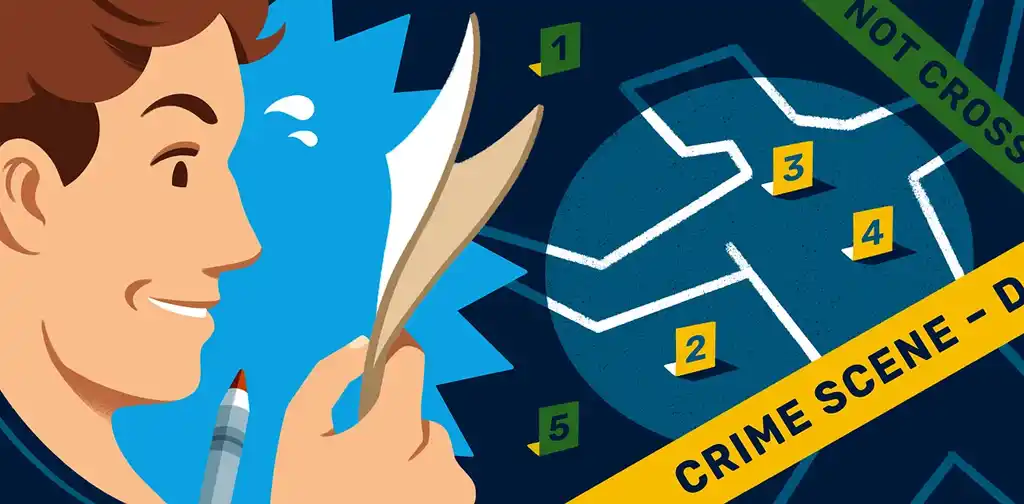Posted on Dec 02, 2020
How to Write a Mystery: The 6 Secret Steps Revealed
About the author
Reedsy's editorial team is a diverse group of industry experts devoted to helping authors write and publish beautiful books.
More about the Reedsy Editorial Team →Martin Cavannagh
Head of Content at Reedsy, Martin has spent over eight years helping writers turn their ambitions into reality. As a voice in the indie publishing space, he has written for a number of outlets and spoken at conferences, including the 2024 Writers Summit at the London Book Fair.
View profile →A great mystery novel will draw in readers with compelling characters, tricky twists, and a clever trail of clues. Of course, the secret to writing a hit like Gone Girl isn’t going to fall into your lap. But in this post we’ll help you strap on your deerstalker, grab your magnifying glass, and crack the code of great mystery architecture!
1. Investigate the subgenres of mystery
You may already know what sort of mystery you want to write. However, it still pays to read plenty of mystery books to get a good grasp on the mystery genre before you start! When it comes to mystery and murder mystery subgenres, here are the usual suspects:
Cozy mysteries
Cozy mysteries often take place in small towns, frequently featuring charming bakeries and handsome mayors. Though the crime is normally murder, there’s no gore, no severed heads in boxes, and no lotion in the basket. As a result, there are rarely any traumatized witnesses or family members in these murder mysteries — making cozies perfect for a gentle fireside read. Example: the Miss Marple series by Agatha Christie.
Recommended reads
- A Guide to Cozy Mysteries [blog post]
- And Then There Were None: The 10 Best Agatha Christie Books [blog post]
Police procedurals
Police procedurals commonly center on a police investigation (betcha didn’t see that one coming). They feature realistic law enforcement work, such as witness interrogation and forensic science, and require a great deal of research to convince seasoned readers of their authenticity. Example: Tana French’s Dublin Murder Squad series.

Noir detective novels
Most associate “noir” with black-and-white films of cynical gumshoes and femme fatales — but did you know that dark, gritty noir novels came first? Their flawed characters and complex plots are renowned for leaving readers in the grey. (Did the investigator do the right thing? Was the culprit really evil?) The crime may be solved by the end, but the mystery itself is rarely so open-and-shut. Example: The Postman Always Rings Twice by James M. Cain.
Prefer your detectives a little more clean-cut? Check out our guide to reading the Sherlock Holmes books!
Suspense
A suspense mystery is all about high stakes and unexpected twists — elements that make it nearly impossible to stop reading. The mystery builds throughout the narrative, clues are painstakingly planted to divulge just the right amount of information, and things are constantly edging towards a dramatic, often shocking climax. Example: Gillian Flynn’s Gone Girl.
Recommended reads
- The 50 Best Suspense Books of All Time [blog post]
🖊️
Which genre (or subgenre) am I writing?
Find out which genre your book belongs to. It only takes a minute!
2. Commit to a crime before you write
While some authors like to write without an outline, improvisation doesn’t lend itself well to the mystery genre. To keep your readers engaged and in suspense, you’ll need to drip feed information bit by bit — which means you’ll need to know your crime and its culprit inside out before you put pen to paper.
Consider not only who committed the crime, but how they pulled it off, and why. Is there anything unusual about their methods, or any specific details you can include that will add texture to your story — say, the lingering smell left behind by a specific real-world poison, or the unusual wounds created by an unconventional weapon? Would anyone else have witnessed the crime — or thought they witnessed it — and if so, how might your criminal keep them silent?
By mapping out and researching your crime, you can think about telltale clues that may have been left behind, and when best to reveal these clues to your readers to keep them hooked. Just make sure you clear your browser history afterwards.
3. Research and pick your setting with purpose
Where your book is set is the backbone of mystery; it fosters the right atmosphere and typically plays a significant role in the plot. But according to crime fiction editor Allister Thompson, far too many mysteries are set in the same old places. “The world doesn’t need another crime novel set in New York,” he says, “or in London if you're British, or in Toronto if you’re from Canada.”

Instead of an overused urban setting, why not set your murder mystery someplace unique? “Not only does it give you more interesting material, it also gives you a really good marketing angle,” Allister says. “The distinct cultural mix and geography of Albuquerque, for example, was a huge part of Breaking Bad’s hook.”
For more tips from Allister, check out this Reedsy Live on mystery writing mistakes and how to avoid them.
This all requires research to execute well. Local news sites should give you an idea of what matters to an area’s residents, the problems they face, and what’s interesting about their community. You’ll come to understand what might actually unfold in a setting like this one, adding depth and authenticity to your mystery.
4. Carve out an intriguing cast of characters
Mysteries are largely about human intrigue, and to pull that off, you’ll need to assemble an interesting cast of characters. Dedicate time to fleshing out your victim, perpetrator, suspects, and sleuth, and you’ll have a much easier time getting readers invested in cracking the case.
To ensure you know your characters inside out, try filling out a character profile — check out our free one below.

FREE RESOURCE
Reedsy’s Character Profile Template
A story is only as strong as its characters. Fill this out to develop yours.
Create a memorable sleuth
Your sleuth, whether they’re a nosy neighbor or a chief inspector, serves as the eyes and ears of your novel — so it’s important that the reader cares about them from the start!
To do this, establish some baseline stakes by determining your sleuth’s motive. What’s stopping them from saying “I guess we’ll never know” and walking away? Would an innocent person be jailed? Will the killer strike again? Or is your sleuth’s motive less selfless, maybe a promotion or a cash reward?
Your sleuth doesn’t have to be a quirky mega-genius a la Sherlock Holmes, but even your “everyman” amateur detective should still be a well-rounded and unique character. Give them idiosyncrasies, interests, and a life outside of the crime, including perhaps a history or connection to the victim that makes them especially invested — “this time, it’s personal…”
Profile your perp
To write a killer culprit, you’ll first need to get their motive right. Your entire plot hinges on this character and their reason for committing a crime, so it has to be thoroughly believable!
Unless you’re dealing with a serial killer (in which case their motive might be more nebulous and unhinged), figuring out your culprit’s motive should always involve the question: What does the killer stand to gain or lose? More often than not, the answer will involve money, passion, or both — or perhaps the oft-pilfered title of “best village baker”, if you’re writing a cozy.

Explore the dynamics between the victim and suspects
For there to even be a mystery, your culprit can’t be the only possible criminal. To keep readers hunting for the truth, try to show your other suspects having any two of the following:
- means (did they have access to a weapon?),
- motive (how would they have benefited from the crime?),
- and opportunity (were they close to the crime scene?).
It’s then the job of the sleuth (and the reader in tandem) to dig out whether they have all three — and even if so, whether they actually did it.
To muddy the waters, explore your victim’s relationship to all the suspects, not just the culprit. A morally grey victim, with a messy past and complex relationships, will allow for more intrigue in your murder mystery. Readers are presented with multiple possibilities, and will have to rule them out in turn as new information comes to light, just like a real detective.
If you want to develop amazing characters to populate your mystery, why not check out our free 10-day course on the subject?

FREE COURSE
How to Develop Characters
In 10 days, learn to develop complex characters readers will love.
5. Build tension throughout the story
The central pillar of any good mystery is the push-and-pull between question and answer. As the author, it’s your job to draw the reader’s attention to the right things at precisely the right moment.
The best way to ensure this is to nail your story shape! By expertly planning your novel’s shift from the unknown to the known, you’ll produce the gripping rise in action that all great mystery novels possess. Here’s how to do just that.
Looking for inspiration for your next mystery story? Look no further than our mystery plot generator!
Hit 'em with a hook
Every story should begin with a great first line, but mysteries are particularly fertile ground for first-rate hooks. Many authors open with the crime. The opening line of Darker than Amber, for example, is brief, unexpected, and action-focused:
“We were about to give up and call it a night when somebody dropped the girl off the bridge.”
— John D. MacDonald, Darker than Amber
There’s no one “right way” to open your mystery novel. But to make sure it’ll capture readers' attention, try to write an opening that a) jolts readers into paying attention, b) leads them to ask further questions, and c) introduces some stakes (conflict, danger, etc.).
Pull out the red string and connect your clues
You’ve successfully enticed readers with your hook! Now, to keep them engaged, you’ll need to structure your plot around the clues to your mystery’s solution.
For this, consult the Fichtean Curve, a type of narrative structure that emphasizes the rise in action, tension and mini-crises — the idea being to keep readers eager to learn more. You must organize your plot so that each new clue ratchets up the tension, until you arrive at the climax.
This moment takes place when the pivotal clue turns up, or when your sleuth realizes the significance of a forgotten lead. What happens at that point leads to your novel's ending.
Give your sleuth time to think
While you may want to make your story as action-packed as possible, it's also important to slow down at times. As well as including those action-oriented info-finding scenes (think: examining the crime scene for physical clues, talking to suspects to glean their alibis), you'll want to include more cerebral scenes that show them thinking or talking through their theory of the case, says Reedsy mystery editor Anne Brewer.
"These types of scenes give you an opportunity to sign post to the reader where the investigation is going (you can even employ misdirection here by having the sleuth make mistakes and get things wrong sometimes), as well as show off their special skills that make them a good investigator."
Consider red herrings
Because they lead the reader down the garden path and away from the truth, you might think red herrings would cause frustration. But when done well, they’re part of the fun, and that’s why they’re a tried-and-true trope of murder mystery.
By upping the tension and escalating the pace, even if it’s towards a dead end, red herrings conjure the signature push-and-pull of the mystery genre. (Not to mention, they keep readers from guessing the answers too soon!)
For a classic mystery bait-and-switch, you might consider:
- a character who appears complicit, but isn’t;
- an object that seems more important than it is (cleverly subverting Chekhov’s Gun!); or
- a misleading clue that was planted by the culprit.
Finally, remember that when it comes to the ending of your mystery, it’s important to play fair. Don’t suddenly introduce an evil twin as the final twist without setting it up earlier! The ultimate conclusion should be both unexpected and earned if you want to satisfy readers, says Reedsy editor Alyssa Matesic.
"You don't want to hint too obviously at the twist (such as who the killer is), because then the reader might put the pieces together prematurely and the reveal scene will feel lackluster and anticlimactic. At the same time, you don't want the twist to feel like it comes out of left field, because then you'll lose the reader's trust. You need to leave just enough breadcrumbs throughout the story so the reader feels like the twist has been right under their nose the whole time."
6. Revise your mystery (with the help of experts)
Once you’ve finished your first draft, you should absolutely celebrate with party poppers and champagne… but then it’s time to transform it into a truly standout mystery! After taking the time to perform a thorough self-edit, summon the courage to send your manuscript out into the world — the world of beta readers, that is.
Beta readers
Beta readers are the invaluable people who read your draft and provide honest, third-party feedback. They can tell you which characters they connected with and which they didn’t, identify plot holes, and point out any other issues you’ve become blind to during your revisions.
As well as asking for general feedback on your story, ask your beta readers to record their working theories as they read. This way you can see whether readers will pick up on clues at the right moment, and whether they’re misled just the right amount by your red herrings.
Professional editor
An experienced mystery editor who eats, sleeps and breathes these books can offer suggestions that even the most talented beta readers will struggle to express.
In the first stages of editing, a developmental editor will provide you with a holistic, in-depth review of your manuscript, helping you examine characterization and redistribute your clues to build to a stunning conclusion.
After producing a second draft, Thompson recommends working with a copy editor: “It’s too competitive out there not to put your best work forward [...] without errors, bad grammar, or spelling mistakes.” So polish up that manuscript like a magnifying glass if you want it to stand a chance of success!

NEW REEDSY COURSE
How to Write a Novel
Enroll in our course and become an author in three months.
So, there you have it! If you follow these six steps, you should be well on your way to giving mystery readers what they crave — a thrilling tale of bad guys, cliffhangers, and diligent sleuths. But if you want to test out your new knowledge on a smaller scale first, head over to Reedsy Prompts and investigate our archive of mysterious short story starters to kick things off.








